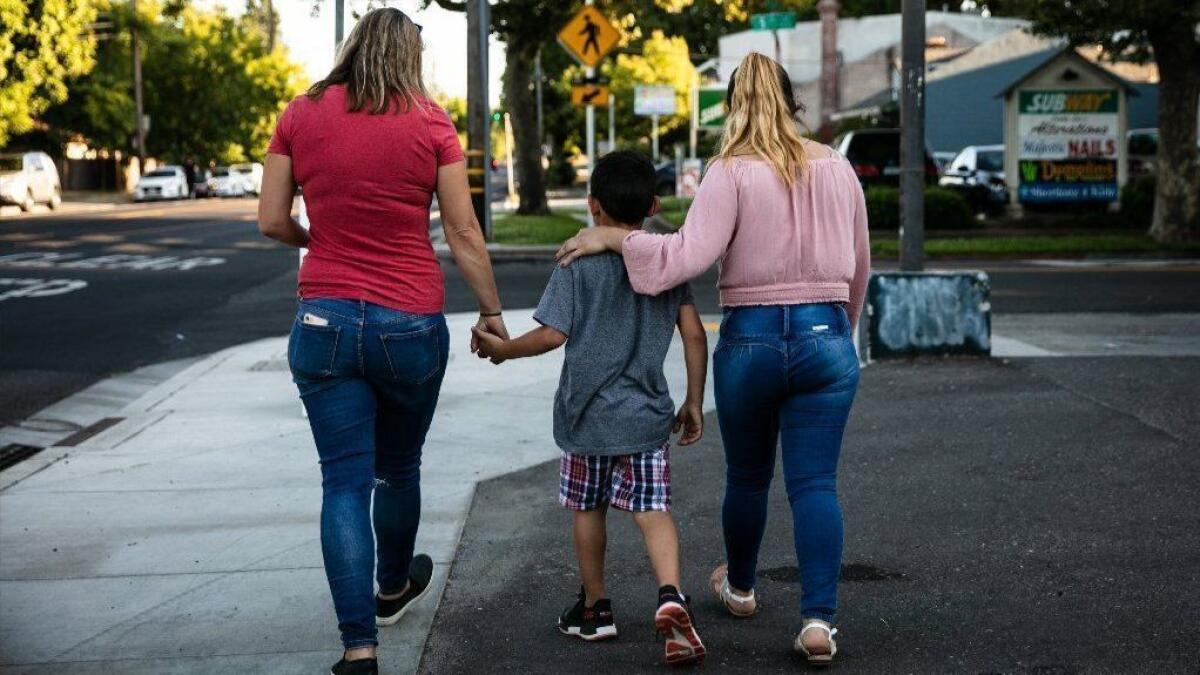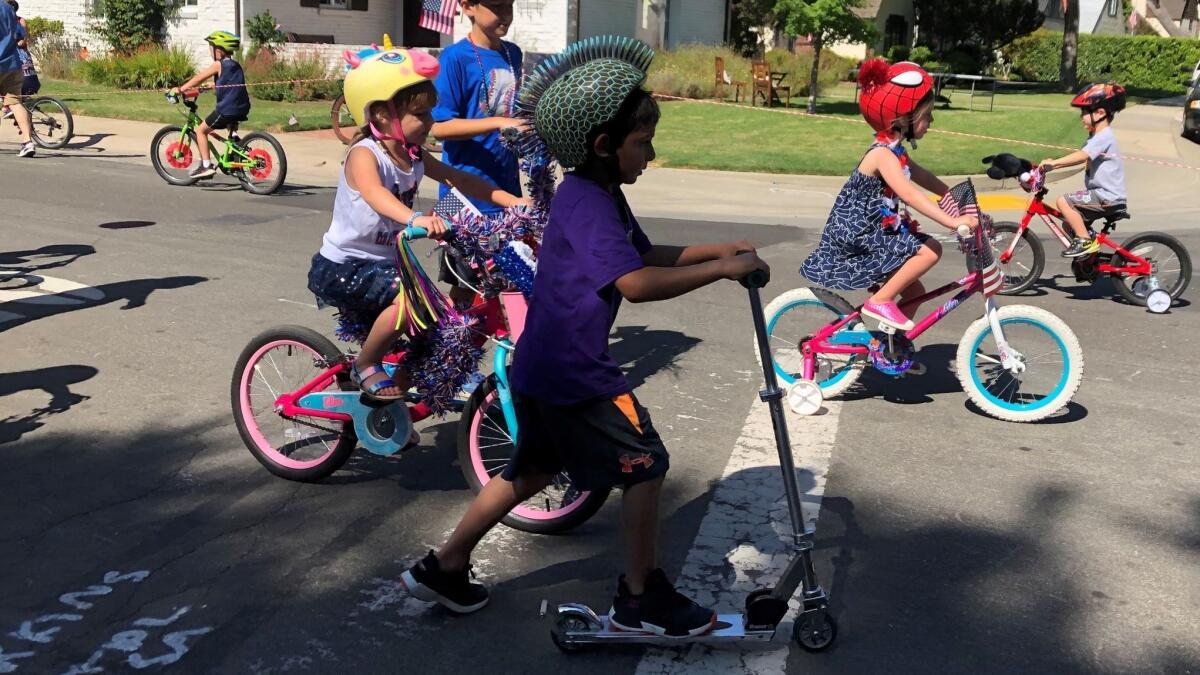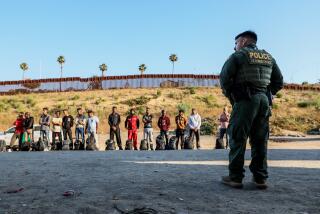Refugee mothers separated at border to sue Trump administration for $3 million each

- Share via
SACRAMENTO — Like thousands of Central American parents seeking asylum in the United States, Patricia panicked when, after she and her son crossed the Rio Grande into Texas last year, U.S. border agents took the boy away. For weeks, she was crushed by fears that then-6-year-old Alessandro was lost forever.
Though they were eventually reunited, Patricia isn’t ready to put the past behind her. She wants the U.S. government to pay for her family’s ordeal, and she has become part of a novel legal strategy to achieve that goal.
“Every moment that I think about it makes me cry,” said Patricia, who asked that she and her son be identified only by their middle names because she fears retaliation. “To have us separated was an injustice. Everybody has the right to want a better life.”
Patricia and her lawyer, Maggy Krell, a former California deputy attorney general who specialized in human trafficking, are set to argue that the U.S. government intended to inflict emotional distress on families by separating them. They plan to make that assertion under the Federal Tort Claims Act, a narrow law that allows individuals to sue the U.S. government for negligence and misconduct. About a dozen other immigrant parents with experiences like Patricia’s are in the process of making similar claims, which will probably end up in courts.
Though it is far from clear they will prevail, the parents argue that the separations and the silence around the fate of their children in 2018 were part of a systemic campaign of psychological intimidation by the Trump administration to frighten others away from entering America.
There’s been ongoing public debate on the purpose of family separations, and last year a federal judge halted them. But Krell and others think the claims could mark a new financial front in the legal battle over the treatment of families and children crossing the border. It comes as national attention is focused on overcrowded and unhygienic conditions at shelters and detention centers, including reports of continuing family separations and an effective end to asylum announced Monday.
“If policy doesn’t work, if lobbying doesn’t work, if press doesn’t work, oftentimes government having to pay for the wrongs it has committed is the best way to get the government’s attention,” said Erik Walsh, a lawyer with the Washington law firm Arnold & Porter, which is spearheading the claims as part of its pro bono work on immigration issues. “The government clearly intended to inflict emotional distress. There is a pretty good record out there of high-ranking government officials … saying this policy was meant to deter other immigrants.”
Walsh said that though government data show about 2,700 children may have been separated from parents or guardians, he expects no more than a few hundred emotional-distress suits to be filed. Some parents have been deported, some are hard to find and many are afraid of drawing government scrutiny as they fight for legal status through asylum and other immigration relief, he said. But those suits may be enough, if they are successful, to set a precedent that could force policy change to avoid payouts, he added.
“This is just a start,” Walsh said.
The first group of claims was filed directly with U.S. Customs and Border Protection and other agencies this year, a required administrative step. The first lawsuits will probably be filed in August. Patricia’s administrative claim will be filed in coming days. The lawsuits will seek $3 million for each affected person, $6 million per family, Walsh said.
U.S. Customs and Border Protection declined to comment on the cases citing pending litigation.
Patricia said she is bringing the claim in part because “there are many mothers suffering,” and she and Alessandro continue to struggle with the effects of their separation. She said she left Honduras because she wanted Alessandro to live in a safe place, but now she isn’t sure when they will feel secure again.
“I can’t forget everything that happened,” she said. “I carry it with me.”
For nearly three weeks after they were taken into custody by U.S. Border Patrol agents in June 2018, Patricia had no idea what had happened to her son, she said. She and Alessandro, now 7, were separated after a single night in a hielera, one of the ice-cold cells that have become a symbol of harsh conditions at the border. She remembers regretting she even made the journey from Honduras.

Authorities took her to Port Isabel Detention Center near Brownsville, Texas, with no access to lawyers, no money for phone calls and no answers to her pleas for information, she said. Rumors swirled that once taken, children were put up for adoption.
It was about 20 days before she heard Alessandro’s voice again. Patricia received a note with the phone number for the shelter where Alessandro was being held, though she is unclear who sent the information. Another detainee mom lent her the money to make a four-minute call.
“I was … wanting to cry and scream, but I made myself strong so I wouldn’t make him feel bad,” said Patricia. “He would ask me, ‘Mommy, when are we going to be together, when are we going to be reunited?’ And I would say, ‘Ya, mijo, ya,’ ” a phrase meant to soothe.
After that call, she didn’t have the funds to contact him again. She couldn’t eat or sleep. She lay in her bed crying and asking God for help, she said. Guards told her crying would only make her situation worse. When Krell first visited, Patricia thought it was an answer to her prayers.
Krell spent 15 years as a state prosecutor before leaving to become lead counsel at Planned Parenthood Affiliates of California last year, just as the government introduced a “zero tolerance” policy at the border, under which those apprehended crossing into the U.S. between ports of entry were criminally charged and separated from their children. Krell said Planned Parenthood decided to send her to volunteer pro bono in Texas because the issue fell within the organization’s mission to “help families.” She was given Patricia’s case by a civil rights firm working with detainees.
She asked her friend Clara Levers, a current California deputy attorney general, to take vacation time and come as a translator. But despite the decades they had spent working with law enforcement, Krell said she was “freaked out” by the convoluted and isolating situation the detainees faced.
“It’s like a void,” she said. “The fact that [Patricia] had a kid didn’t matter to them in terms of their determination whether she should be deported.”
Krell and Levers discovered that border agents had not recorded Patricia and Alessandro as related and she was on track to be removed from the country without him. He was considered an unaccompanied minor, like other children separated under the zero-tolerance policy, said Krell. U.S. authorities had already sent others back to home countries without their kids, Levers said. Ultimately, about 400 parents were deported without their children. Levers said it was “terrifying.”
“They did not care about that link,” Levers said, and it became a race to “halt the wheels” of Patricia’s removal.
With no record associating mother and son, Krell was able to find the boy only by using a list of alien registration numbers given to immigrants when they are detained. She located Alessandro because his number was close to his mother’s. Krell managed to get Patricia released five weeks after she had been separated from Alessandro, after she passed a “credible fear” interview and was put on the legal track toward asylum. In the intervening time, a court had ordered separated families to be reunited, and President Trump had signed an executive order ending the zero-tolerance policy.
Patricia and Krell drove to the facility where the boy was being held in a shelter with about 100 other kids, but authorities there wouldn’t let her see him without an appointment. As Krell and Patricia stood arguing with officials, a line of children walked by, Alessandro among them, Krell said. When he saw his mother, he ran to her and didn’t want to let go.
“He said, ‘Mom, I’m leaving now with you,’ ” said Patricia, a petite 27-year-old who shares apple cheeks with her son. “But they didn’t give him to me.”
It took another week to have Alessandro released, Krell said. Once free, he clung to his mom, she said.
They are now living with Patricia’s brother, and she is working legally at a Korean fast-food chain. Alessandro just completed first grade.
But she is anxious, and sometimes her mind goes “cold,” a blankness that leaves her disoriented, she said. Alessandro is scared to be apart from her, even at school. He cries spontaneously.
“He’ll wake up in the middle of the night crying,” she said. “And then he’ll turn and hug (me) and say, ‘OK, we’re together, mom.’ ”
Despite the anguish many separated parents face, their claims of emotional distress may be hard to win, said Gregory Sisk, a law professor at the University of St. Thomas in Minnesota and an expert in federal tort law.
“Anytime you sue the federal government in these types of cases, it’s an uphill climb,” Sisk said. “You’d have to show that it was done … for the purposes of being cruel as opposed to, ‘We’re not very competent and we don’t want to take the time.’ ”
Sisk said the lawsuits are “worthwhile” but largely unprecedented for their focus on emotional distress. Congress passed the Federal Tort Claims Act a year after a military pilot became disoriented in heavy fog and crashed a B-25 Mitchell bomber into New York’s Empire State Building in 1945, killing 14 people. Before the legislation, individuals could not sue the federal government because it held sovereign immunity. But wanting to respond to the families of the crash victims seeking their day in court, Congress created limited circumstances under which such cases could be heard.
It has since been used mostly by individuals, though there have been a few significant, mostly unsuccessful, group claims, including from property owners flooded by Hurricane Katrina who claimed that the failure of government-built levees was to blame. But in February, a Honduran refugee, Suny Alvarado, won a $125,000 settlement in a lawsuit that alleged U.S. Immigration and Customs Enforcement held her and her son in inhumane conditions and threatened family separation in 2015, partly to pressure her to drop an asylum claim.
After her experience helping Patricia and Alessandro, Krell said, she believes there is “an absolute vacuum of information” around detainees that is part of a “heartless” policy that falls under the scope of the law.
“The more I’ve gotten to know Patricia and Alessandro, the more repulsive it is that this is how they were treated,” Krell said. “She is not that different from some of the human trafficking victims I’ve worked with, some of the assault survivors I’ve worked with. She was the victim of horrific circumstances. It just happens to be that the people who put her in that position are the federal government.”
More to Read
Sign up for Essential California
The most important California stories and recommendations in your inbox every morning.
You may occasionally receive promotional content from the Los Angeles Times.











